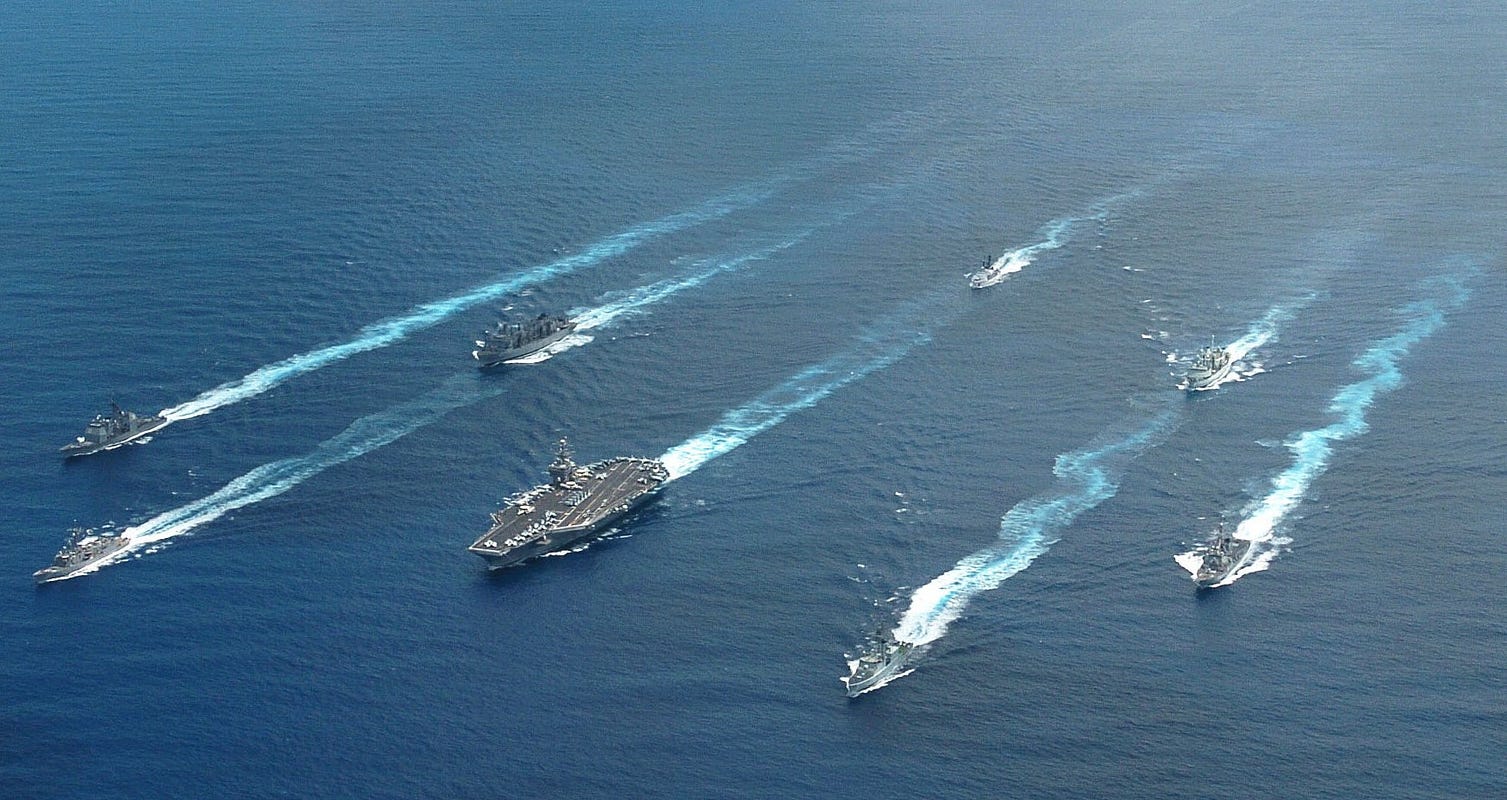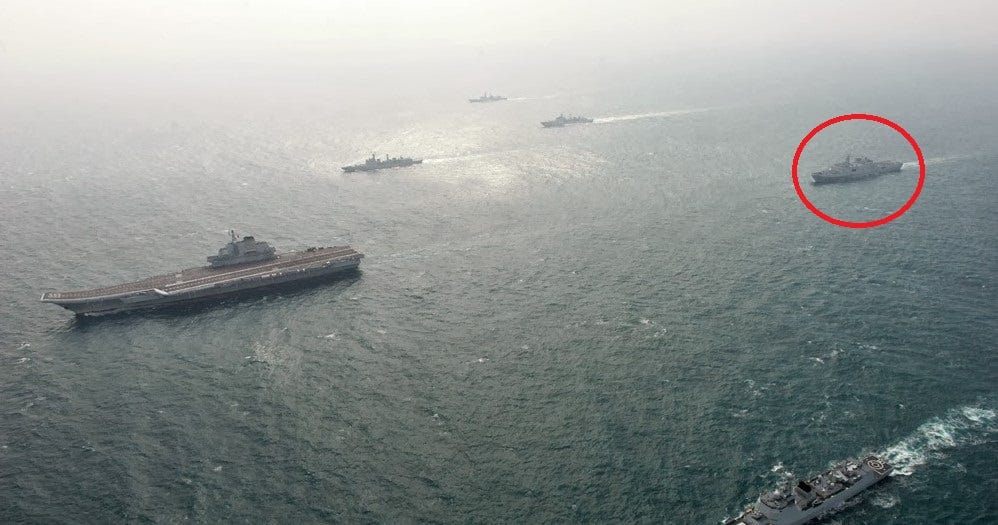China’s first aircraft carrier Liaoning has returned to her home port of Qingdao on the Chinese east coast, wrapping up a month-long exercise that saw the refurbished Soviet-built flattop and her escorts sail south to the waters near Taiwan for the first time—oh, and also risk war by almostramming an American cruiser.
To celebrate the carrier battle group’s reckless, madcap first deployment, the Chinese Navy staged an impressive aerial photo op of Liaoning and 10 other warships: three destroyers, three frigates, three submarines and an amphibious assault ship. Eight jet fighters also make appearances.
Such carrier battle group glamor shots are common in the U.S. Navy, which always has three or so of its 10 flattops deployed around the world. Aping the Americans’ naval vanity helps the Chinese project an image of equal strength, however misleading that image might be.But the details of the Liaoning battle group’s portraits also reveal the weaknesses in Chinese naval organization as Beijing struggles to match the world’s leading maritime power.

An American-led carrier group with two logistics ships. Navy photo
Where are the logistics ships?The true secret to American naval power is not the numerous and powerful front-line warships, but the less visually impressive vessels that you rarely see on TV or read about in the news.They are logistics ships, including tankers, dry stores vessels and ammunition ships. The Pentagon’s three-dozen active combat-support vessels, manned mostly by civilian mariners, busily crisscross the globe, carefully plotting their courses to regularly meet up with the carriers and other task forces in order to refuel and resupply them.
Without logistics ships, the U.S. Navy would never venture far from its major home ports in Virginia, Florida, California and Hawaii. These vital but unattractive supply vessels occasionally enjoy the privilege of appearing in carrier battle group photo ops.
But no logistics ships are visible in Liaoning’s recent photos. That could be because China possesses only a token naval logistical flotilla—and mostly uses it to support Beijing’s counter-piracy force off of East Africa. “Limited logistical support remains a key obstacle preventing the [Chinese] Navy from operating more extensively beyond East Asia,” the Pentagon reported recently.
It’s no accident that in her two years of trials, Liaoning has never sailed far from the Chinese coast. Her recent deployment to the South China Sea was the farthest she’s traveled from Qingdao, but the voyage still kept her only a short distance from shore bases.Indeed, the main reason for the southern exercise was for the flattop to visit a new purpose-built carrier pier recently constructed in the city of Sanya. The Chinese will have real reason to boast the first time Liaoning heads into the deep ocean with only logistics ships to keep her supplied.

Why is one of China’s three Type 071 amphibious assault ships tagging along behind Liaoning in the group photos? While an impressive vessel in her own right, the Type 071 is incompatible with a flattop like Liaoning.
Amphibious ships such as the Type 071 are meant to sail near to an enemy’s shore—as close as 25 miles—and disgorge helicopters, hovercraft and flat-bottom landing craft to put soldiers on a defended beach. By contrast, carriers sail in deep waters, launching planes at great distance in order to strike the enemy or defend other fleet units. A flattop sitting just 25 miles off an enemy coast is begging to be bombarded and sunk.
Frigates and destroyers might sail close to the amphibs in order to protect them from enemy attack, resulting in amphibious groups that look a lot like carrier groups but, in fact, are totally different in function. Amphibs get close, carriers stay far. Blending the two types of capital ships in the same battle group necessarily renders one of the big vessels useless.
The Type 071's presence in Liaoning’s group could indicate inexperience on the part of Chinese admirals. More likely, it’s mere theater. The Type 071 could have joined the group just for the snapshots … or accompanied the carrier without ever practicing any real-world operations—a projection of power utterly lacking in substance.

In American carrier group photos, any aircraft that appear are usually planes launched by the flattop. But the four jet fighters featured in one of the Chinese photos are actually land-based JH-7 fighter-bombers that, owing to their short range, probably wouldn’t play any meaningful role in open-ocean combat.
To be fair, four carrier-launched J-15 fighters do appear in another snapshot. But look closely: the J-15s carry no weapons under their wings. BecauseLiaoning doesn’t have a catapult—rather, she boosts her planes into the air using an angled “ski ramp”—she can launch only lightly-loaded jets.
With a modest fuel load, the J-15 weighs more than 25 tons and can take off from Liaoning while carrying just a few bombs and missiles. And even then the fighter’s range is reportedly limited to less than a hundred miles. One shockingly negative report from Chinese
state media in September called the J-15 a “flopping fish.”America’s catapulted carrier jets like the F/A-18 can carry more than the J-15and fly farther, making U.S. flattops much more
useful in wartime.
So enjoy Liaoning’s recent photo op for what it really is: an act of self-promotion by a navy that’s acquired a lot of new equipment in recent years but is still learning and growing—and still trails the U.S. Navy by nautical miles.
No comments:
Post a Comment